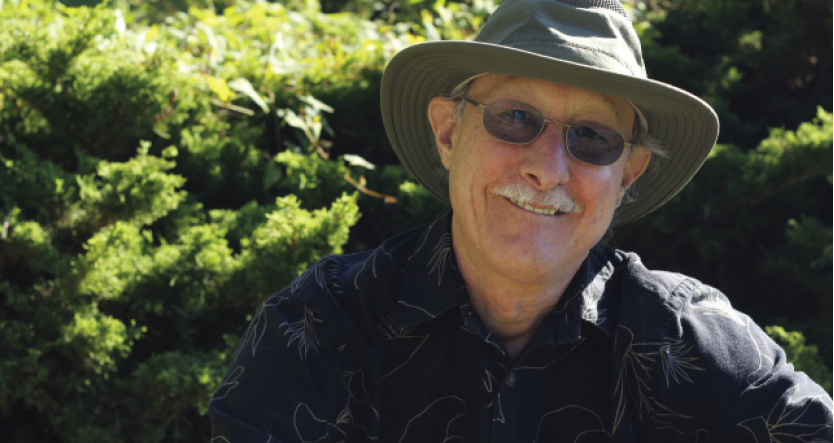Haitian art collections from David A. Kravitz, 1970-2000
/Haitian Paintings from the David A. Kravitz Collection, 1970-2000
David A. Kravitz ’s father, the late Boris Kravitz, assembled the collection, based on his experience as the founder of the Haitian Art Company in Key West, Florida, which operated from 1980 until 2009. The gallery acquired and sold a variety of original Haitian art, including paintings, sculptures, and spirit flags used during Vodou ceremonies.
Painted in vibrant colors, the works present an idyllic vision of Haiti, emphasizing lush tropical landscapes, picturesque maritime imagery, scenes of everyday life, and themes from Haitian Vodou rituals. Created primarily for the tourist market, the works belie any hint of political turmoil, poverty, or religious conflict that marked Haiti’s history and instead present timeless vistas of Caribbean life.
Special thanks to David A. Kravitz for donating this special resource to the University Art Collection.
Photo credit: Ashley A Fetterman
The collection is displayed in Enterprise Hall rooms ENT 204 and ENT 243A, as well as in the hallway and reception areas of the dean's suite. You can also obtain a catalog of the exhibition, where Art History and Arts Management students delved into Haitian history and religion, the history of art creation and scholarship in Haiti, and the influence of the tourist market on artistic production in the region. Their writings on these subjects are featured in a concise exhibition catalog, showcased in Enterprise Hall ENT 249, and can be acquired from Mason Exhibitions.


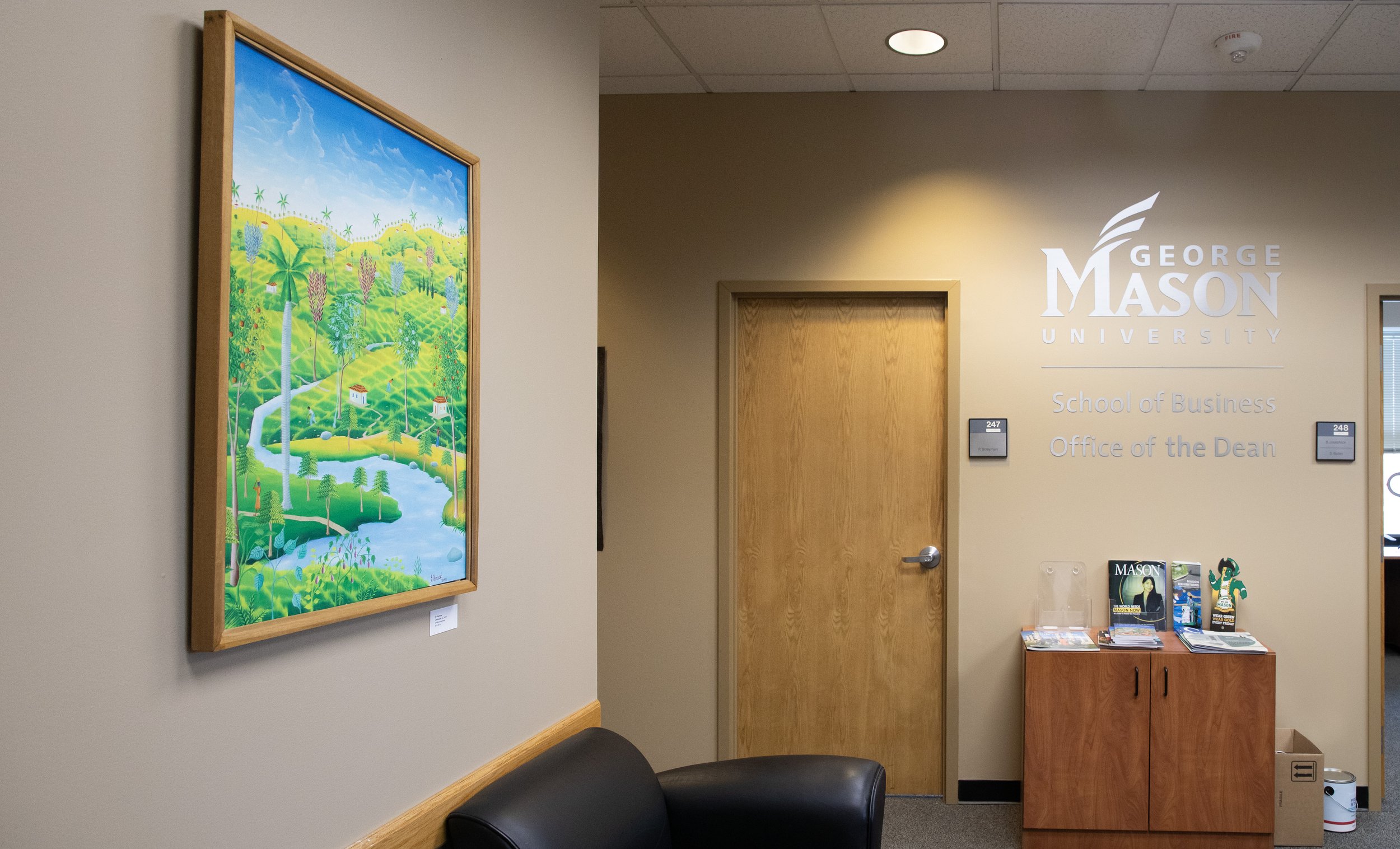
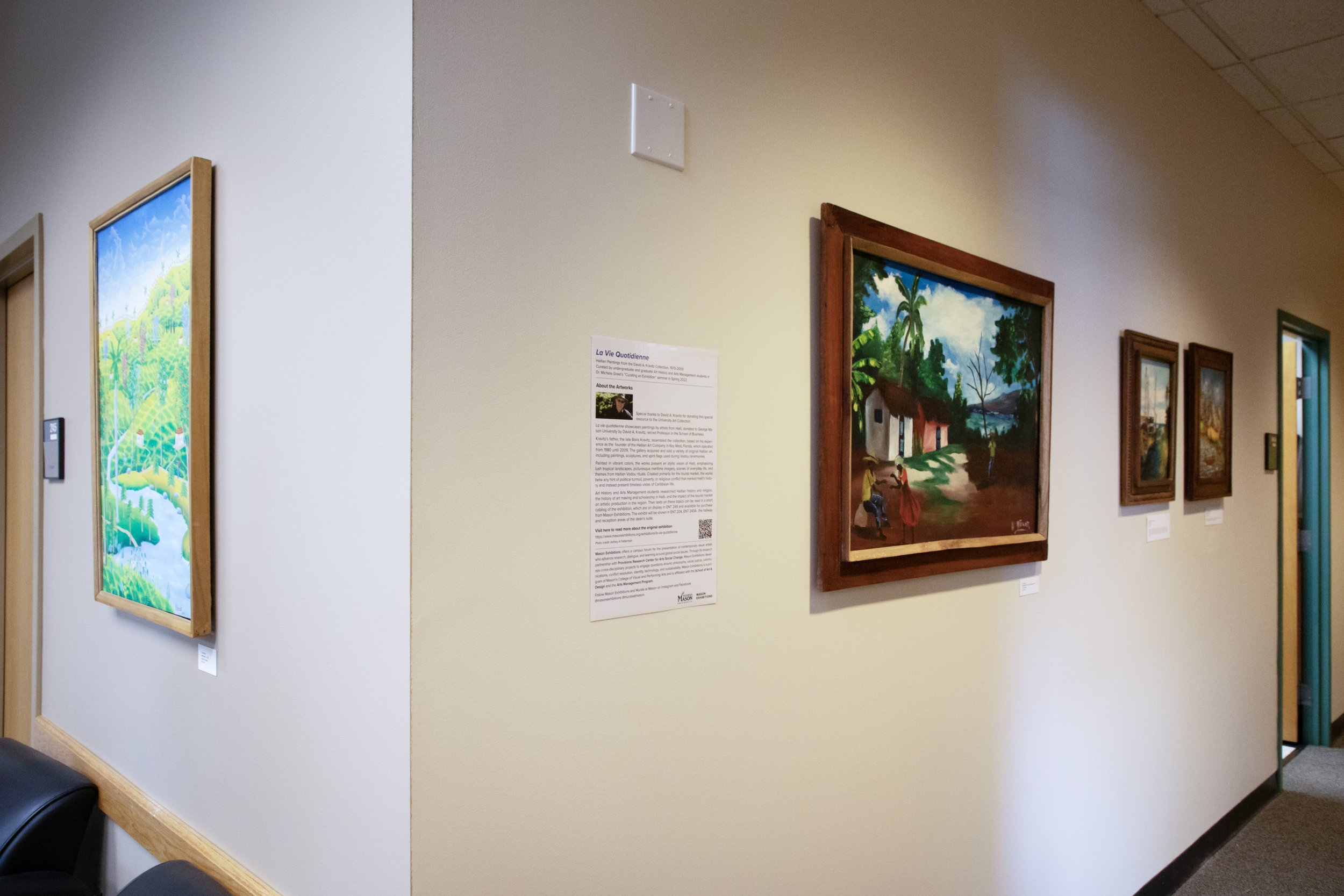
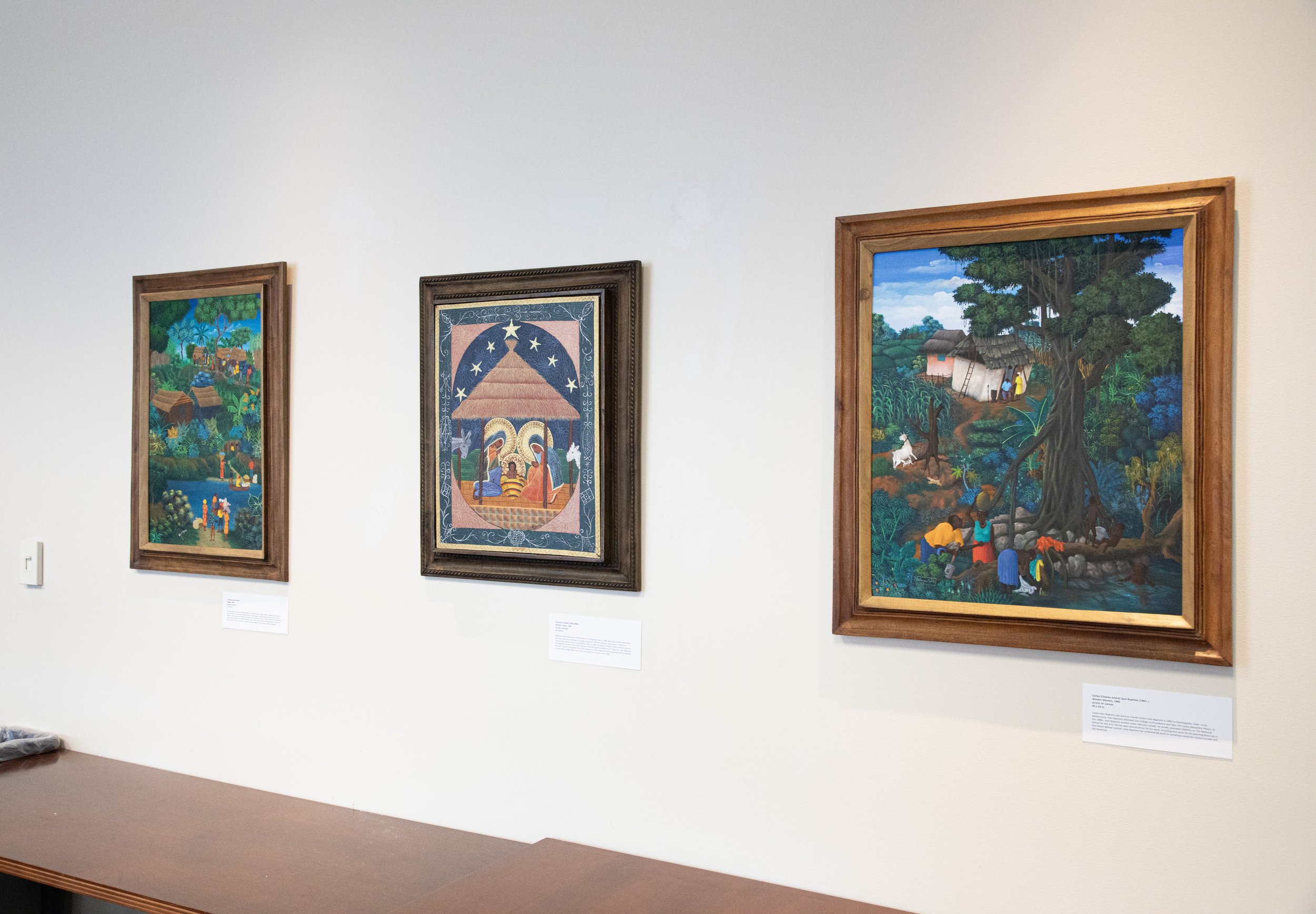
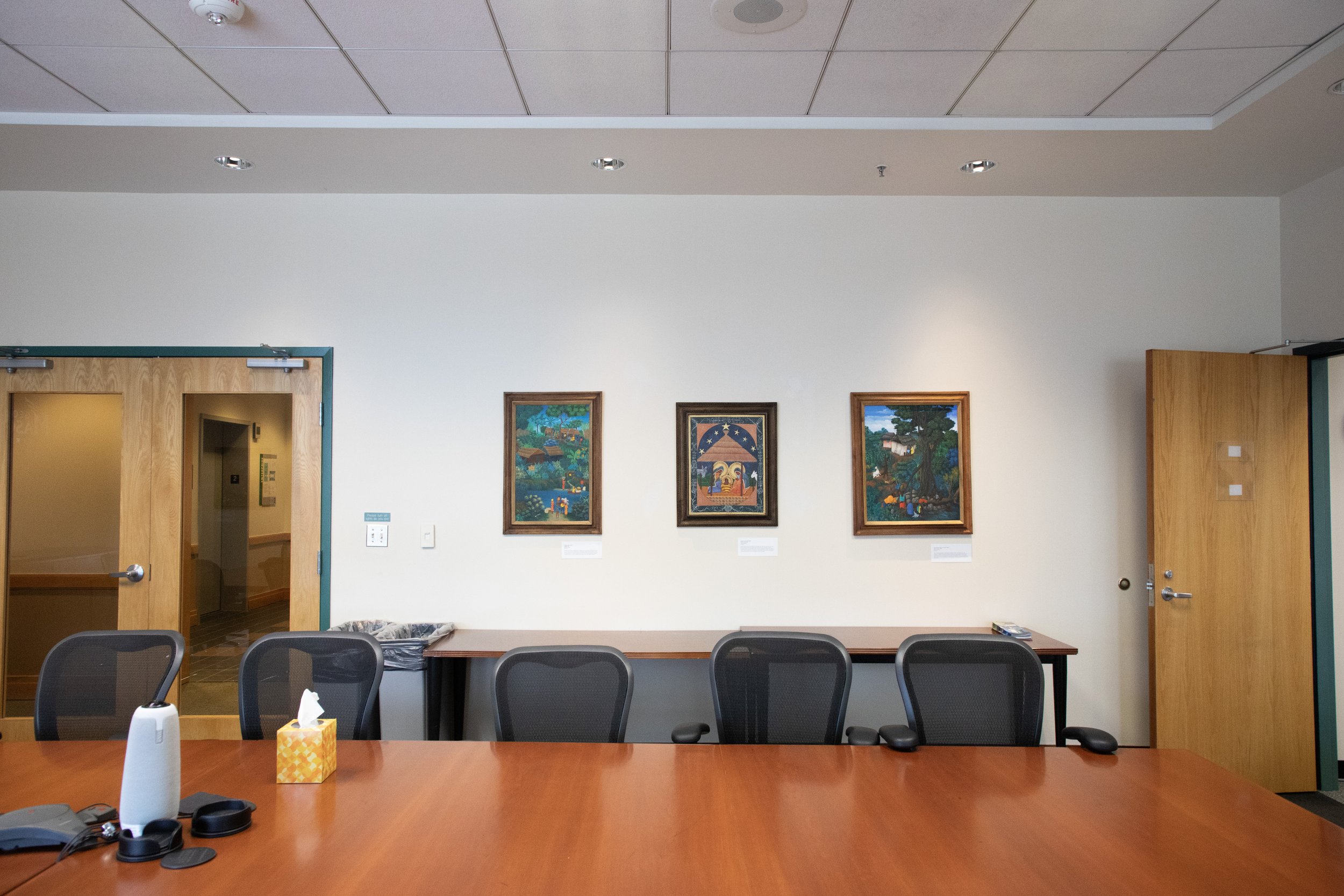

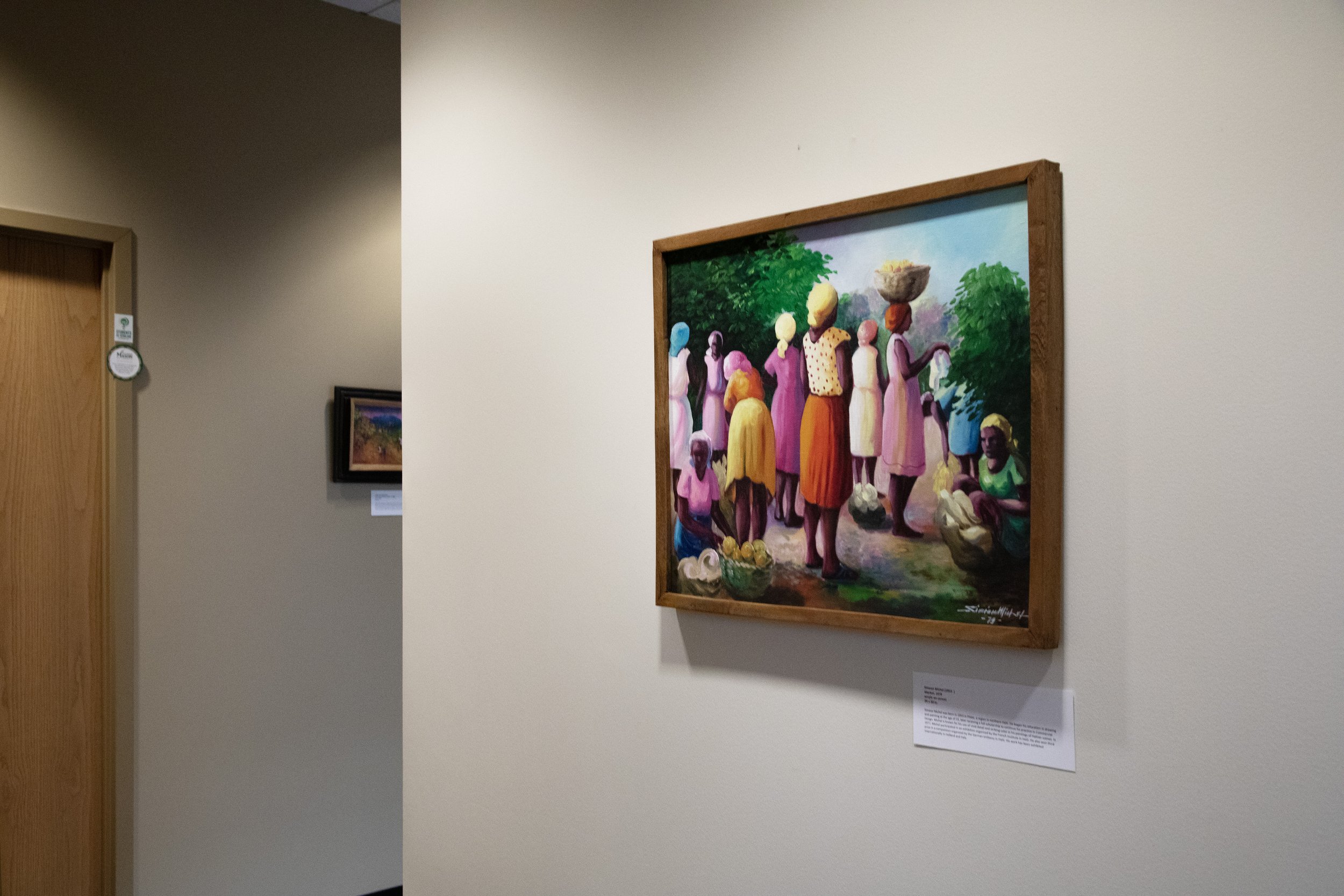
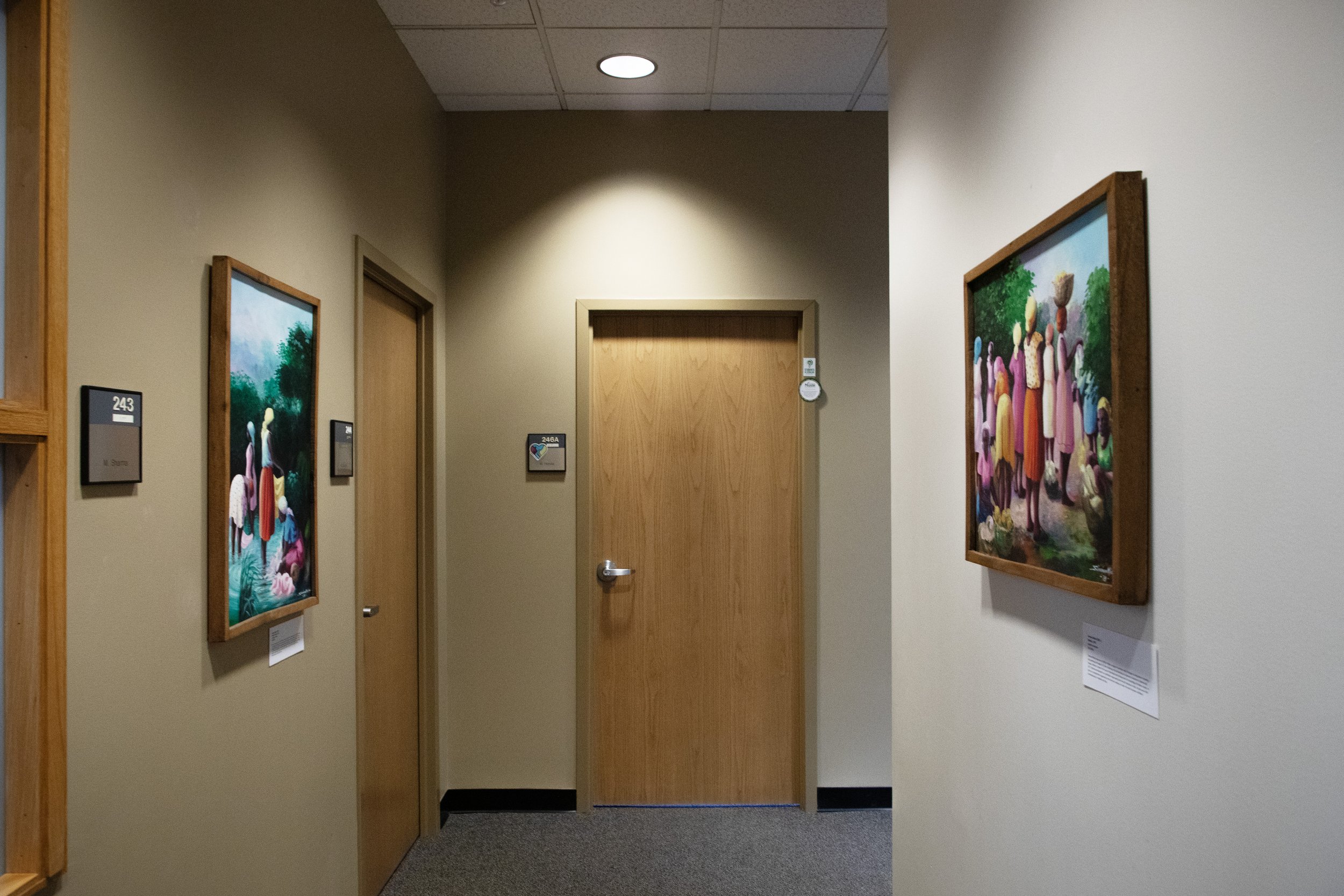
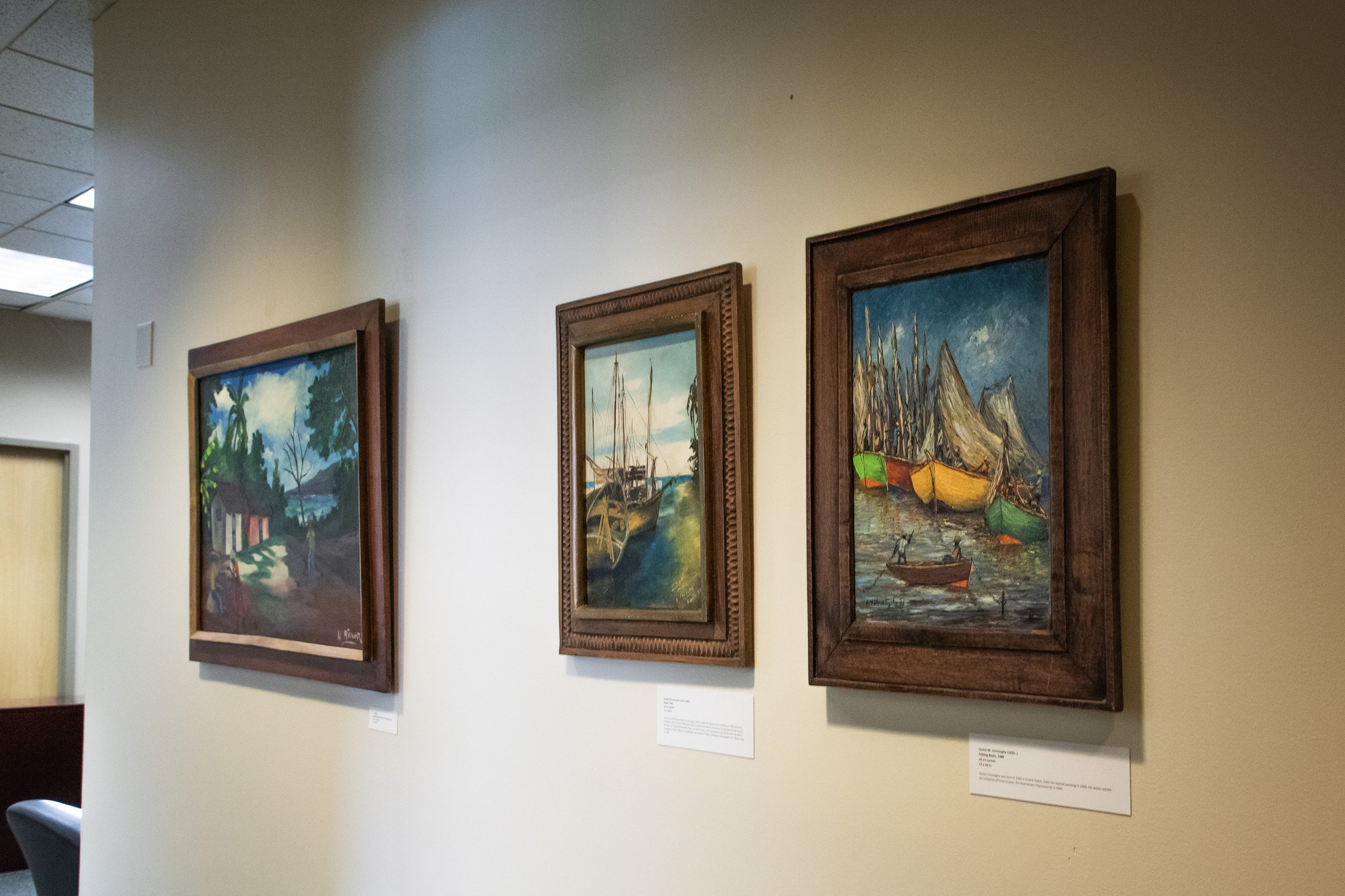
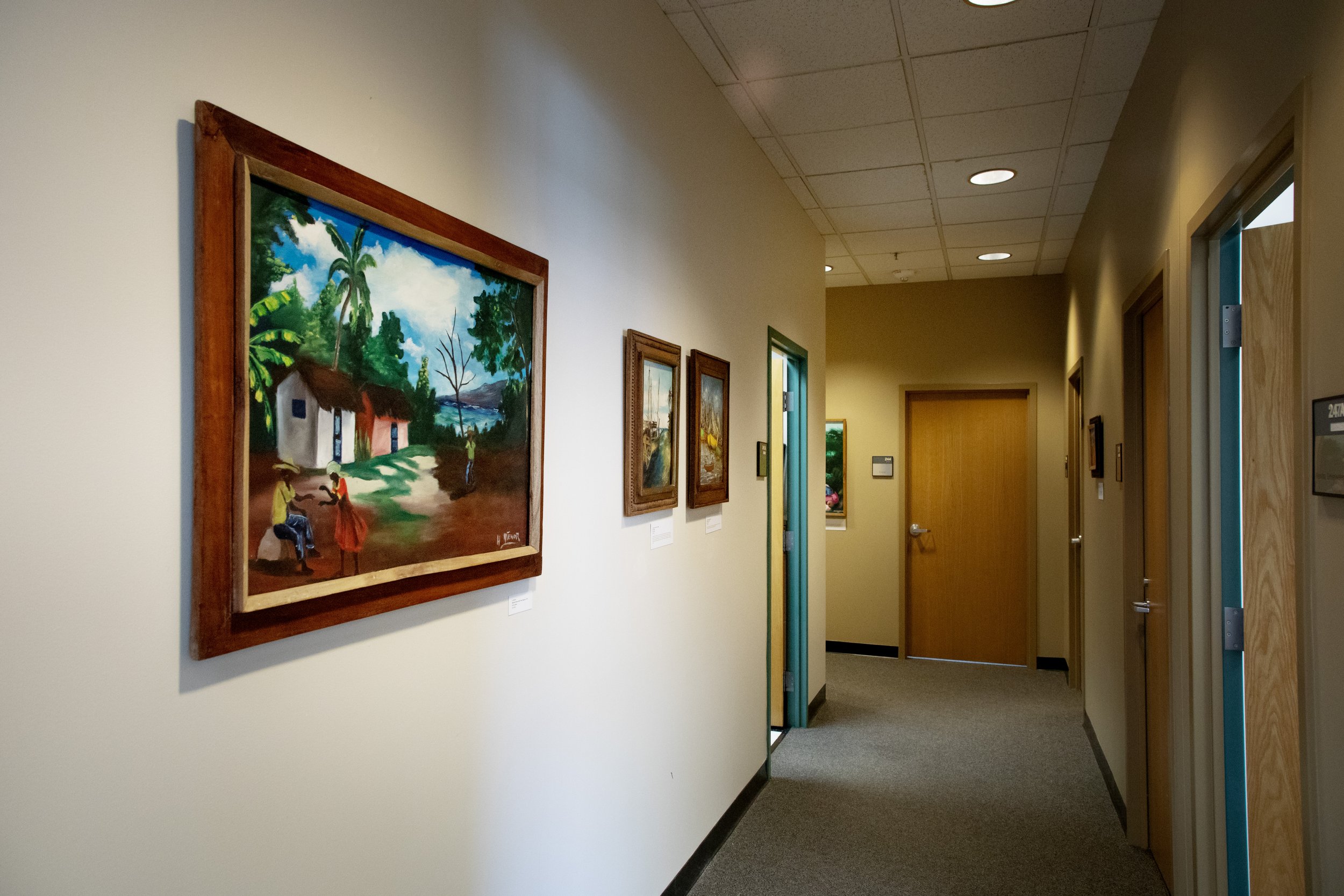
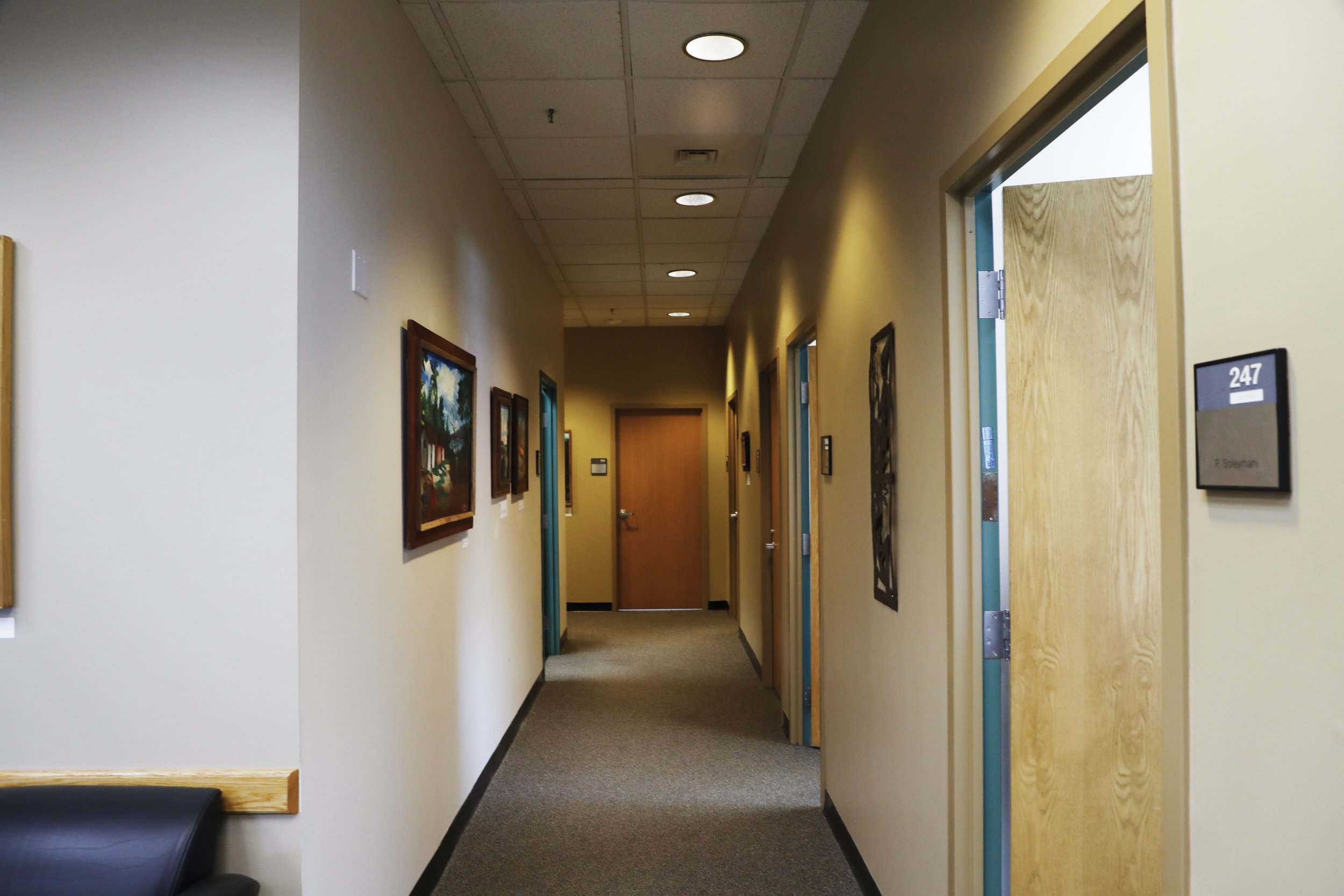
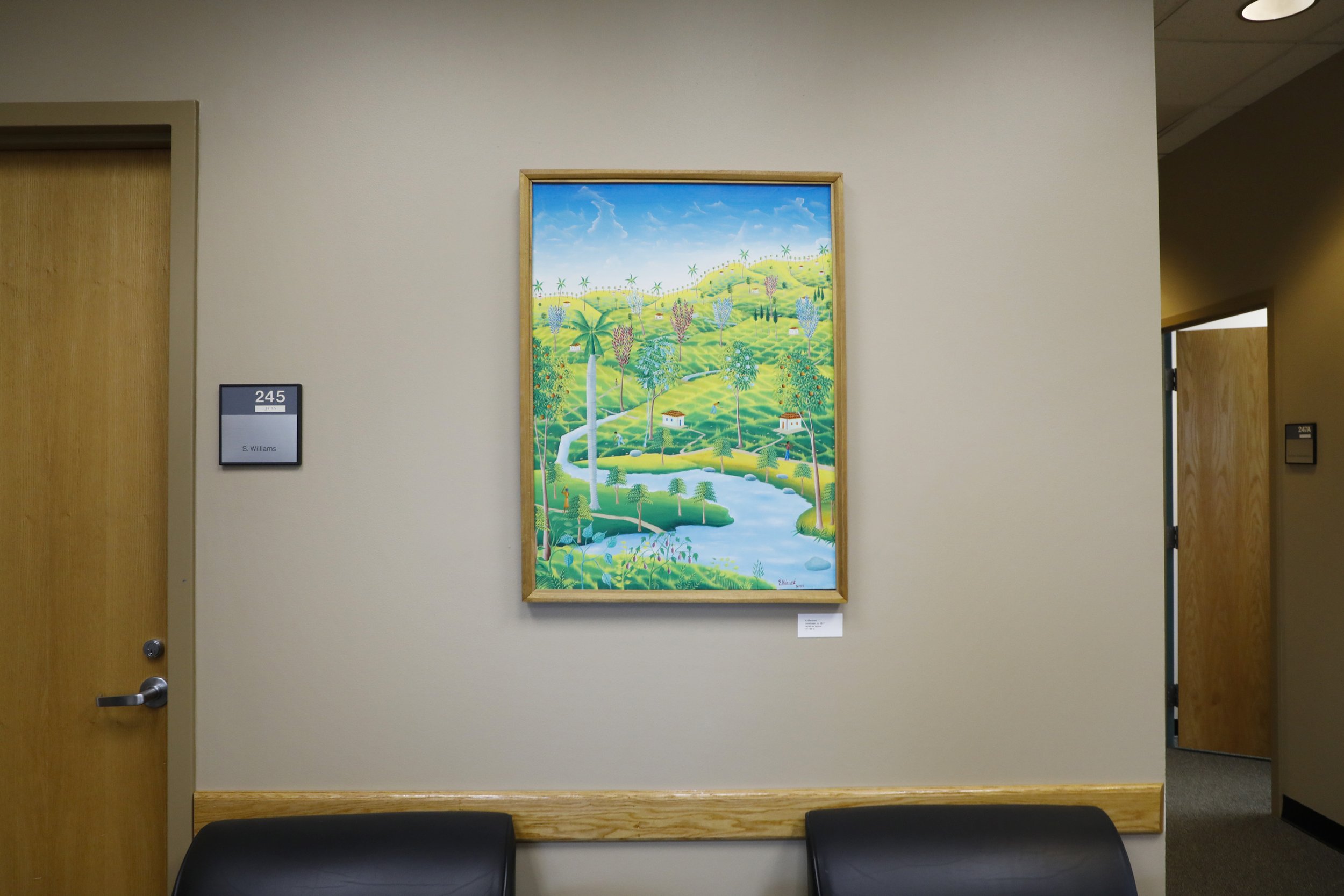
Art in the Shadows: Political, Economic, and Religious Context in Haitian History
Simeon Michel (1953-) Houses on a Hill at Dawn, before 1983 acrylic on canvas 20 x 16 in.
The history of Haiti is filled with silences and reflections of events that often become visible in the art. In Silencing the Past: Power and the Production of History, first published in 1995, Michel-Rolph Trouillot developed a model to describe how historical narratives - both true and false - are created.' He used the Haitian Revolution to explain why a certain narrative coalesced. He described "silences" as voices that are missing from the development of a story. He argues that silences "enter the process of historical production at four crucial moments: the moment of fact creation (the making of sources); the moment of fact assembly (the making of archives); the moment of fact retrieval (the making of narratives); and the moment of retrospective significance (the making of history in the final instance)." Trouillot's theoretical framework applies to historiographic scholarship more broadly but originates specifically from the Haitian context. In order to understand the silences that are in the art, we first must understand the historical circumstances that generated these same silences.
History of Religious Mixing
Prior to the arrival of Christopher Columbus, the Arawak Indians acknowledged the existence of one supreme, invisible, immortal, and omnipotent creator, whom they called Jocahuna. However, Columbus brought Catholicism with him and began a contentious mixing of religions on the island. Thousands of indigenous people were forcibly baptized, but very few were allowed to participate in the Eucharist.
When the colonizers began to bring enslaved Africans to the region, they also brought with them their own belief systems of African Vodou. The traditional view of Vodou is that it is "an African form of magic and witchcraft mixed with New World elements, complete with the ruling mother goddess, a pantheon of lesser deities, a psychic ritual, and a manipulative worldview." African Vodou syncretized with Catholicism to form Haitian Vodou, which combines Catholic rituals and imagery with African customs. Haitian Vodou involves a pantheon of deities as well as rites and spirituality developed around those spirits. Vodou refers not only to the religion but also to ritual dance styles that synchronize the community with the spirits. The relationship between these spirits, or wa, is built on reciprocation. According to Per-Nandez, Murphy, and Paravisin-Gebert, "the Iva offers help, protection, and counsel; their devotees offer ritual service in return, which includes a variety of individual and communal rituals. Privately, the believer will wear the wa's colors, feed the spirits, and make all necessary sacrifices when instructed."
For nearly 200 years, French Catholics tried to teach the enslaved people "Christian civilization" and to stomp out what they viewed as paganism." Erasure tactics were carried out by banning Vodou meetings, and practitioners were punished should they not concede. In 1865, the Catholic Church instigated the Code Noir (Black Code), which was allegedly designed to protect the rights of slaves. Under this code, all slaves must be baptized, receive instruction in the Catholic faith, and attend Sunday Mass and confession. They must also renounce the practice of Vodou. Under the Police Rulings of 1758 and 1777, church leaders further attempted to eradicate Vodou practices, and Vodou practitioners were severely punished for violations. The imposed restrictions included the movement of slaves and the ban on drumming and dancing; moreover, slaves were prohibited from assembling without the presence of a Catholic priest, near their master's homes, or in remote areas. These regulations forced the practice of Vodou underground until the 1790s.
Michel-Ange Altidort (1965-) Butterfly people, acrylic on canvas 12 x 16
Resistance to these ordinances sparked the beginning of the Haitian Revolution. On August 22, 1791, Boukman Dutty, accompanied by an elderly priestess, performed a Vodou ceremony at Bois Caiman, during which they used the "war-like petro spirit of Vodou to organize, plan, and give the signal that began the revolt." During the Revolution, Catholicism almost disappeared as French priests fled the country in protest and in fear for their lives. After the end of the Revolution, the Vatican refused to acknowledge Haiti as a republic, causing a further rift between the Catholic Church and Haiti. In an attempt to regain favor with the Vatican, King Henri Christophe declared Catholicism the official religion of Haiti and sought to suppress Vodou. During this period, Haitians practiced Catholicism in public while keeping Vodou ceremonies private.
Between 1807 and 1842, Haitian presidents worked with the Catholic Church to eradicate Vodou by stamping out the cultural significance of Vodou or trivializing it as folklore. However, with the election of President Faustin Soulouque in 1847, Vodou became more publicly acceptable. Soulouque encouraged the practice of the religion, and members of Hait's elite were able to openly embrace Vodou as a part of their culture. "Catholic orthodoxy rapidly declined as several generations of Haitians received no religious instruction in the faith.
With the appointment of President Fabre Nicolas Geffrard, the rift with the Vatican was healed through the 1860 Concordat. This agreement once again brought Vodou under scrutiny, sparking the anti-superstitious campaigns of 1896, 1913, and 1941, during which ritual paraphernalia was burned throughout the country. As a last-ditch effort to destroy Vodou influence in 1941, President Elie Lescot's government and the Catholic clergy waged what Murrell called "an all-out 'demon hunt' war against Vodou" in an attempt to "save the souls of Vodou devotees from eternal damnation."
Occasionally, Vodou was even weaponized against the Haitian people. François Duvalier presented himself as the embodiment of Vodou powers to instill fear in the peasant class. He encouraged this perception by positioning himself as a servitor or devotee of the Iwa and as a boker (priest who engages in sorcery), as well as by imitating the dress and personality of Baron Samedi, the Iwa of the dead." Despite the renunciation of Catholicism during the Duvalier dictatorships, the American occupation of Haiti and the post-Duvalier era saw further persecution of Vodou.
'The Haitian Constitution of 1987 finally established freedom of religion in Haiti. President Jean-Bertrand Aristide, elected in 1990, further supported this freedom and allowed Vodou devotees to practice without political and religious repercussions. In 2003, Aristide enacted legislation that allowed Vodou to be recognized as a legitimate and official religion. Because of this ruling, his image appears on many Vodou altars."
Paintings from the Kravitz collection highlight this historical and religious intermingle. Several works include biblical imagery, such as Obès Faustin's Jungle Scene with Animals (Garden of Eden?) and Gabriel Bien-Aimé's Adam and Eve. Saincilius Ismaël's Nativity Scene is an excellent example of religious syncretism. While the main subject is the Christian nativity scene, the heart symbols refer to Er-zuli, the Vodou Iwa (spirit) of love and motherhood. She could also be interpreted as Ezili Danto, another manifestation of Erzuli. Ezili Danto is often shown in red and blue, as the Virgin Mary is depicted in this painting. Ezili Danto is often equated with the Virgin Mary or other iterations of Madonnas with children.
Jean Baptiste, Carlos, Child with Water Sprit, ca.1991, acrylic on canvas, 8 x 16 in
Some of the other paintings from the Kravitz collection reference Vodou more overtly. Included in this category are Michelange Altidort's Butterfly People and Carlos Jean Baptiste's Child with Water Spirit. Altidor's Butterfly People shows Mistress Lasiren, another Iwa, in her form as a mermaid. Lasiren is thought to bring good luck and wealth from the bottom of the sea. She is often represented as Our Lady of Charity, the Cuban patroness (Nuestra Señora de la Caridad Cobre). The Iwa in Baptiste's Child with the Water Spirit is a bit more difficult to identify. It could be a general water spirit who concerns themselves with the affairs of children and appears in a variety of forms, or Loko, Iwa of vegetation, guardian of sanctuaries, and personification of plants." The scene could also possibly represent the island of Grand Bois d'Llet, where the Iwa live in submerged forests and welcome the souls of the dead.
Other paintings, such as Jacques-Enguerrand Courgue's Fish, Face, and Boats (sec. Fig. 4), suggest more oblique references to Vodou. The man in the image could be interpreted as Agwe, one of the primary Iwa. Agwe is the protector of ships at sea, marine and aquatic life, and fishermen. Rituals to summon Agwe take place at sea, and he is usually summoned by conch shells, like the ones seen in this painting. Agwe is usually shown with a fish and is syncretized with Saint Ulrich or the archangel Raphael. Evidence of religious mixing in these paintings is visible through the lens of the long history that came before them.
Artists:
H. Altenor, Michel-Ange Altidort, Gesner Armand, Gabriel Bien-Aimé, Saint Louis Blaise, Dieudonne Cedor, Anatol Charles, E. Cherisme, Osmin M. Christophe, Obès (“OB”) Faustin, Lafortune Felix, M. Germain, Jacques-Enguerrand Gourgue, Calixte Henri, Saincilius Ismaël, Acciméus James, Carlos (Charles André) Jean Baptiste, Carlo Jean-Jacques, F. Joseph, Louines Mentor, Simeon Michel, Benson Myrthil, Louverture Poisson

